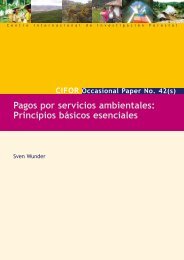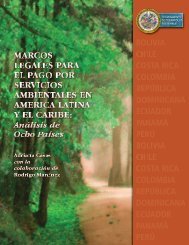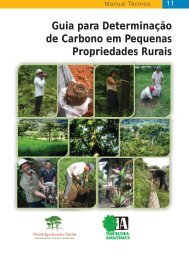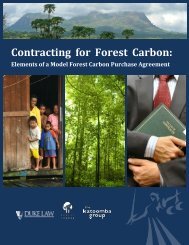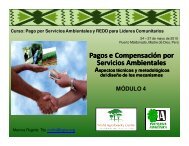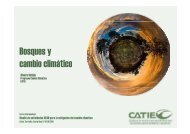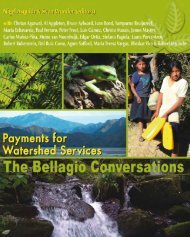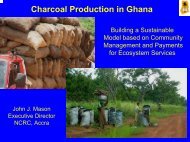Guide on Climate Change and Indigenous Peoples
Guide on Climate Change and Indigenous Peoples
Guide on Climate Change and Indigenous Peoples
- No tags were found...
Create successful ePaper yourself
Turn your PDF publications into a flip-book with our unique Google optimized e-Paper software.
• Proxy means that simplified but c<strong>on</strong>servative input assumpti<strong>on</strong>s areused to measure how emissi<strong>on</strong>s levels changed. For example if <strong>on</strong>eneeds to calculate how much emissi<strong>on</strong>s are saved because of reduceddeforestati<strong>on</strong>, a default value for forest carb<strong>on</strong> c<strong>on</strong>centrati<strong>on</strong> per hectarecan be used. In Brazil they are using 100tC per hectare.• Funding will be through ex-post payments. Total amount of carb<strong>on</strong>emissi<strong>on</strong>s reduced will be what will be paid for. The payments for thismay be: Market-linked - n<strong>on</strong>-offset market funds which can come from:m levy <strong>on</strong> internati<strong>on</strong>al aviati<strong>on</strong> <strong>and</strong> maritimem levy from drivers of deforestati<strong>on</strong> such as the logging <strong>and</strong>timber industriesm aucti<strong>on</strong>ing of allowances under a self-c<strong>on</strong>tained cap <strong>and</strong> traderegime for internati<strong>on</strong>al transport, <strong>and</strong>/orm pledge of a certain percentage of nati<strong>on</strong>al aucti<strong>on</strong>ed emissi<strong>on</strong>strading allowances <strong>and</strong> a percentage of AAUs aucti<strong>on</strong>ed in theinternati<strong>on</strong>al market Market-based - fund is from the compliance carb<strong>on</strong> offset market.This has to be agreed up<strong>on</strong> yet at the UNFCCC negotiati<strong>on</strong>s.Phase 3: Payments for emissi<strong>on</strong>s reducti<strong>on</strong>s <strong>and</strong> removals which areverifiedThis is a more full-fledged implementati<strong>on</strong> of Phase 2’s sec<strong>on</strong>d comp<strong>on</strong>ent.Here, the nati<strong>on</strong>al REDD strategy - designed with rights holders <strong>and</strong>stakeholders - will be fully implemented. This will be financed throughex-post payments for verified emissi<strong>on</strong>s reducti<strong>on</strong>s or removals measuredfrom an established baseline. This phase will be elaborated further at theUNFCCC negotiati<strong>on</strong>s.13 C<strong>on</strong>clusi<strong>on</strong>• REDD+ is such a complex issue even if the idea seems very simple:Give rewards to those who are keeping their forests st<strong>and</strong>ing. In thebeginning, there was no discussi<strong>on</strong> at all about indigenous peoples. Thecurrent state of the negotiati<strong>on</strong>s is a direct result of indigenous peoples’efforts to lobby negotiators.• This is not an issue <strong>on</strong> the divide between Parties - between north <strong>and</strong>south; or developed versus developing. But rather, the debate in theUNFCCC is directly linked to human rights <strong>and</strong> ecosystems approachwhich makes some governments very uncomfortable.96 <str<strong>on</strong>g>Guide</str<strong>on</strong>g> <strong>on</strong> <strong>Climate</strong> <strong>Change</strong> <strong>and</strong> <strong>Indigenous</strong> <strong>Peoples</strong>



